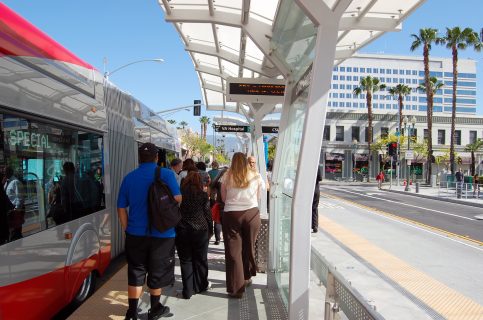The Egyptian Transport Minister Kamel al-Wazir recently announced that the actual construction of the first 10 Bus Rapid Transit (BRT) system stations, as part of the ongoing development of a BRT system on Cairo’s Ring Road, has begun following the completion of the architectural and construction diagrams.
The minister made the announcement during an inspection tour to the Suez – Asher Station – al-Marj – Mostorod – Bahtim – stations, and the intersection of the Ring Road with Cairo-Alexandria Agricultural Road, where the work has already begun.
Also Read: Construction of Bus Rapid Transit lanes on Cairo Ring Road to begin
The construction of the remaining stations according to al-Wazir is underway.
Other features of the BRT system on Cairo’s Ring Road
Other than the construction of the stations the BRT system project on Cairo’s Ring Road also includes the construction of car parks and development of BRT special lines that will be connected with the third metro line at Adly Mansour Station in Cairo and Road Al Farag Axis Station in Giza.
The lines will also be linked with the planned fourth and sixth lines and the extension of the second line in Qalyoub.
Also Read: Egypt to establish a Bus Rapid Transit system on Ring Road, Cairo
According to al-Wazir, there are some global alliances interested in cooperating with the Transport Ministry in the management and operation of the BRT buses, noting that the optimal advertising and investment exploitation will be made for all BRT stations.
Development of the Cairo City Ring Road
Following the development and expansion of Cairo’s Ring Road, the Egyptian Transport Minister said, a total of six lanes will be dedicated for private cars, and an internal lane designated for the BRT buses.
This brings the total number of lanes to seven in each direction, except for the Moneib Bridge, which will have a total of eight lanes in each direction.
In May 2021, al-Wazir said that his ministry shall also incorporate the Intelligent Transportation System (ITS) into the Ring Road, making it the first road in the North African country to use this system.
Background
September 2020: Egypt to establish a Bus Rapid Transit system on Ring Road, Cairo
The government of Egypt through the ministry of Transportation plans to introduce a Bus Rapid Transit (BRT) system in Greater Cairo’s Ring Road.
The implementation of the plan according to Kamel al-Wazir, the Egyptian minister for transportation, will kick off after the completion of the ongoing development and expansion works of the ring road, increasing the number of its lanes to eight in each direction.
Also Read: Construction of Bashteel Railway Station in Giza, Egypt starts
Features of the BRT project plan
The BRT project plan features the construction of BRT bus stations and car parks along the Ring Road for the convenience of the passengers. The BRT special lines will be connected with the third metro line at Adly Mansour Station in Cairo and Road Al Farag Axis Station in Giza. It will also be linked with the planned fourth and sixth lines and the extension of the second line in Qalyoub.
The project will be supervised by the state’s Ministry of Transport in cooperation with local authorities in Cairo, Giza, and Qalyubiya.
The operation of the ultimate system will be awarded to one or more specialized companies in an Initial Public Offering (IPO).
The conception of the BRT system plan
In November last year the Egyptian Minister of Transport discussed with the Swedish Ambassador to Cairo Jan Thesleff ways of cooperation in road safety. The latter pitched the idea of developing the Bus Rapid Transit (BRT) systems in the North African country.
Fast forward, in February this year, the Egyptian Minister of Transport paid a visit to Volvo factories in Gothenburg, Sweden, where he and the officials from Volvo discussed the project.
The meeting highlighted the BRT system’s effectiveness in linking “smart cities,” or urban areas that make use of information and communication technologies (ICT) to improve the quality of energy, transportation, utilities, and other services, with the aim of reducing waste and overall costs.

